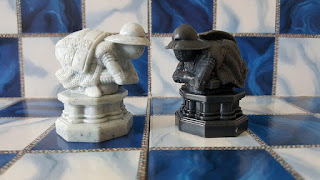I'm reading an awesome series of books right now: Brandon Sanderson's "The Reckoners." It's the dystopic vision of a world wherein super villains arose, but there were no superheroes to fight them. The use of powers corrupted these characters and turned them into ruthless, amoral monsters who took over the world and turned its cities into their own personal fiefdoms. The books have wit, great characterization, a fresh story clear of cliches, and, basically, everything I look for in a series. I could talk about any one of these things.
But one of the aspects I find most entertaining is the running gag of conversation on the subject of metaphors and similes. A character is considered either sharp or dull based on how well they can handle metaphoric language. The main character is criticized because his metaphors keep falling flat. "Man," [the main character] thought, "I really do suck at metaphors." Another character is hailed for his ability to handle metaphors and similes deftly.
Simile vs. Metaphor:
For those not clear on the difference, a simile has the word "like" or "as" in it. One great simile from Firefight, the second novel in the series, is, "The overworked machine hung out over a plummet of many stories, dripping water like perspiration from the forehead of a suicidal jumper." [There's nothing intrinsically dangerous-seeming about an air conditioner, but in that moment, the world symbolized by that machine is on the verge of destruction.] Another segment a couple of paragraphs later is rich with similes. "I lowered my popsicle and squinted at the strange red light, which rose like a new star above the horizon. [...] It looked like a bullet wound in the dome of heaven itself." [The new star in the heaven brings to mind the biblical story of the birth of Jesus, which event transformed how many humans viewed their world. The same is true here but in a different way. The bullet wound in heaven simile suggests that the change that was coming would be destructive.] These moments become rich with imagery as we feel the connotations of the things to which events in the story are compared. [Emphasis added in above quotations.]
A metaphor does not have the emotional distance that simile bears. This item or event is not just like that. It IS that. The symbol and item become merged through the comparison. To borrow a Shakespearean metaphor, “All the world’s a stage"("As You Like It.") The world isn't LIKE a stage. It IS a stage. This kind of comparison ties symbol to symbolized much more closely. When Sanderson says the light mentioned in the quotations above "blanketed the entire city in a strange warm glow," the idea of a blanket is tied so closely to the light that the light becomes not just like a blanket. It becomes the blanket itself. Just like a blanket provides the illusion of safety in a dangerous world, so, too, does that light.
Power of the Metaphor:
Regardless of whether an author uses simile or metaphor, this kind of comparison livens the language and makes the whole piece more interesting. I've been reading a story by a fellow writer in my writers' group that is the master of metaphor and simile. This kind of language elevates her pieces above so many others' pieces because it draws on sensory language. A less deft writer may write, "Her beauty made him happy." We can't see beauty. We don't know what happiness means to the character, necessarily. These words remain flat on the page. Say instead, the writer wrote, "Her glowing profile sent sunlight through the dark corners of his soul." We can see glow, sunlight, and darkness, and corners. We know her face isn't literally glowing, that it doesn't bring sunlight and that there really aren't corners in the guy's soul. All of this is metaphoric. But the reader can feel the glow and understand the connotations of sunlight as something powerful. There is a gravitational pull to the sun. These words have ceased to remain flat ink on the page; they have given birth to an image in the reader's mind.
Dos and Do nots
There are three cautions I'd make with using this kind of symbolic language.
1. Avoid cliched metaphors and similes like the plague. Yes, that was a cliched simile. You probably rolled your eyes or read quickly over it. Cliches are boring. We've read them so often, they have become meaningless. When Shakespeare first wrote, "dead as a doornail," it was likely a fresh turn of phrase meaning as lifeless as a key. Now, it's just part of the language. Nobody even knows what "doornail" means anymore. And if you think about it, dead implies once had life. And keys really don't and never had. However, "dead as a roadkill opossum" may seem a bit fresher and more meaningful. You haven't heard it as many times, so it makes you think. It brings to mind [unfortunately] sensory imagery and all the connotations of a dead, smelly marsupial with a long history in the Western United States. It may suggest dirty rodent to someone less well versed in biology. But it's not a cliche. This brings me to number two.
2. Avoid using metaphors that don't belong. Comparing a medieval dragon to a modern blowtorch wouldn't work very well. It would jar the reader out of the narrative, unless the author is going for humor. Stay in the world. Make sure your metaphors and similes actually belong.
3. Avoid using so much description that your narrative becomes purple, meaning that your story has been choked out by description so lush that nothing happens. Descriptive language is best in small doses in most writing.
In other words, metaphors and similes turn flat language into round, interesting language as long as they are used sparingly and in a way that livens the text without bogging it down.









